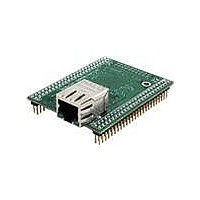MOD5234-100IR NetBurner Inc, MOD5234-100IR Datasheet - Page 393

MOD5234-100IR
Manufacturer Part Number
MOD5234-100IR
Description
MOD5234 10/100 ETHERNET MODULE
Manufacturer
NetBurner Inc
Type
Controllers & Processorsr
Datasheets
1.MOD5272-100IR.pdf
(3 pages)
2.MOD5234-100IR.pdf
(4 pages)
3.MOD5234-100IR.pdf
(754 pages)
Specifications of MOD5234-100IR
Interface
I²C, SPI, UART
Voltage - Supply
2.5V
Mounting Type
Surface Mount
Package / Case
Module
Product
Modules
Lead Free Status / RoHS Status
Lead free / RoHS Compliant
Data Format
-
Baud Rates
-
Lead Free Status / Rohs Status
Lead free / RoHS Compliant
Other names
Q4483564
- Current page: 393 of 754
- Download datasheet (13Mb)
Memory Map/Register Definition
19.2.5.1 Driver/DMA Operation with Buffer Descriptors
The data for the FEC frames must reside in memory external to the FEC. The data for a frame is
placed in one or more buffers. Associated with each buffer is a buffer descriptor (BD) which
contains a starting address (32-bit aligned pointer), data length, and status/control information
(which contains the current state for the buffer). To permit maximum user flexibility, the BDs are
also located in external memory and are read in by the FEC DMA engine.
Software “produces” buffers by allocating/initializing memory and initializing buffer descriptors.
Setting the RxBD[E] or TxBD[R] bit “produces” the buffer. Software writing to either the TDAR
or RDAR tells the FEC that a buffer has been placed in external memory for the transmit or receive
data traffic, respectively. The hardware reads the BDs and “consumes” the buffers after they have
been produced. After the data DMA is complete and the buffer descriptor status bits have been
written by the DMA engine, the RxBD[E] or TxBD[R] bit will be cleared by hardware to signal
the buffer has been “consumed.” Software may poll the BDs to detect when the buffers have been
consumed or may rely on the buffer/frame interrupts. These buffers may then be processed by the
driver and returned to the free list.
The ECR[ETHER_EN] signal operates as a reset to the BD/DMA logic. When ECR[ETHER_EN]
is deasserted the DMA engine BD pointers are reset to point to the starting transmit and receive
BDs. The buffer descriptors are not initialized by hardware during reset. At least one transmit and
receive buffer descriptor must be initialized by software before the ECR[ETHER_EN] bit is set.
The buffer descriptors operate as two separate rings. ERDSR defines the starting address for
receive BDs and ETDSR defines the starting address for transmit BDs. The last buffer descriptor
in each ring is defined by the Wrap (W) bit. When set, W indicates that the next descriptor in the
ring is at the location pointed to by ERDSR and ETDSR for the receive and transmit rings,
respectively. Buffer descriptor rings must start on a 32-bit boundary; however, it is recommended
they are made 128-bit aligned.
19.2.5.1.1 Driver/DMA Operation with Transmit BDs
Typically a transmit frame will be divided between multiple buffers. An example is to have an
application payload in one buffer, TCP header in a 2nd buffer, IP header in a 3rd buffer,
Ethernet/IEEE 802.3 header in a 4th buffer. The Ethernet MAC does not prepend the Ethernet
header (destination address, source address, length/type field(s)), so this must be provided by the
driver in one of the transmit buffers. The Ethernet MAC can append the Ethernet CRC to the
frame. Whether the CRC is appended by the MAC or by the driver is determined by the TC bit in
the transmit BD which must be set by the driver.
The driver (TxBD software producer) should set up Tx BDs in such a way that a complete transmit
frame is given to the hardware at once. If a transmit frame consists of three buffers, the BDs should
be initialized with pointer, length and control (W, L, TC, ABC) and then the TxBD[R] bits should
be set = 1 in reverse order (3rd, 2nd, 1st BD) to insure that the complete frame is ready in memory
MCF5235 Reference Manual, Rev. 2
Freescale Semiconductor
19-29
Related parts for MOD5234-100IR
Image
Part Number
Description
Manufacturer
Datasheet
Request
R

Part Number:
Description:
MCU, MPU & DSP Development Tools MOD5234 MODULE
Manufacturer:
NetBurner Inc
Datasheet:

Part Number:
Description:
MCU, MPU & DSP Development Tools MOD5234 Core Module Development Kit
Manufacturer:
NetBurner Inc
Datasheet:

Part Number:
Description:
BOARD SERIAL-ETHERNET 512K FLASH
Manufacturer:
NetBurner Inc
Datasheet:

Part Number:
Description:
PROCESSOR MODULE FLASH MOD5272
Manufacturer:
NetBurner Inc
Datasheet:

Part Number:
Description:
PROCESSOR MODULE 512KB FLASH
Manufacturer:
NetBurner Inc
Datasheet:

Part Number:
Description:
DUAL PORT SERIAL-ETHERNET
Manufacturer:
NetBurner Inc
Datasheet:

Part Number:
Description:
PROCESSOR MODULE FLASH
Manufacturer:
NetBurner Inc
Datasheet:

Part Number:
Description:
PROCESSOR MODULE 512KB FLASH
Manufacturer:
NetBurner Inc
Datasheet:

Part Number:
Description:
KIT DEVELOP NETWORK FOR MOD5282
Manufacturer:
NetBurner Inc
Datasheet:

Part Number:
Description:
KIT DEVELOP NETWORK FOR MOD5272
Manufacturer:
NetBurner Inc
Datasheet:

Part Number:
Description:
DUAL PORT SERIAL-ETHERNET
Manufacturer:
NetBurner Inc
Datasheet:

Part Number:
Description:
Ethernet Modules & Development Tools 32 Bit 66MHz 40 Pin DIP Industrial Temp
Manufacturer:
NetBurner Inc
Datasheet:

Part Number:
Description:
Ethernet ICs 32bit 147MHz CAN-to- Ethnt Device IndTemp
Manufacturer:
NetBurner Inc
Datasheet:










